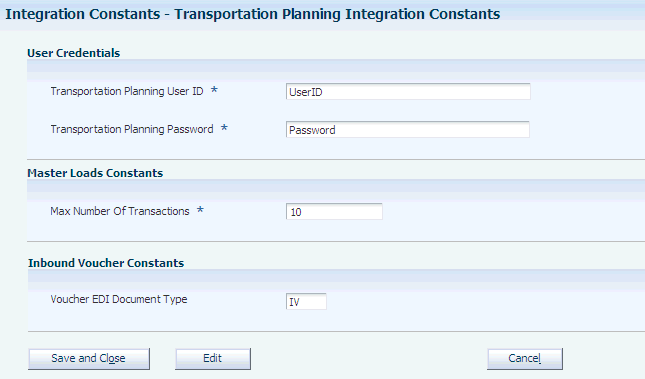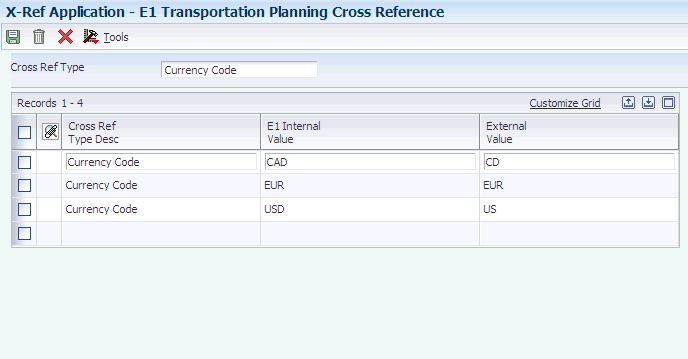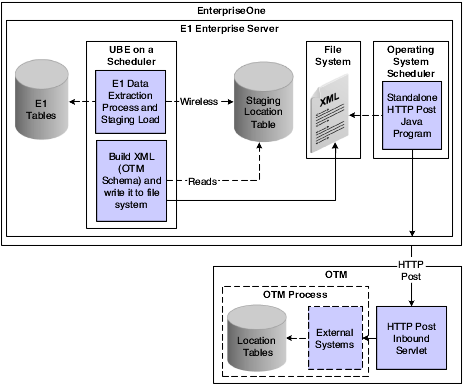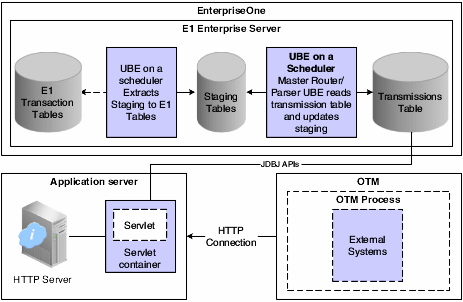2 Integrating JD Edwards EnterpriseOne with Oracle Transportation Management
This chapter contains the following topics:
-
Section 2.3, "Setting Up Transportation Planning Integration Constants"
-
Section 2.5, "Setting Up Shipping Document and Line Type Combinations"
-
Section 2.9, "Assumptions and Requirements of the Integration Process"
2.1 Understanding the JD Edwards EnterpriseOne to Oracle Transportation Management Integration
This diagram illustrates the process flow and technology used to successfully import and export data from JD Edwards EnterpriseOne and Oracle Transportation Management:
Figure 2-1 JD Edwards EnterpriseOne to Oracle Transportation Management Process Flow and Technology [Release 9.1 Update]

Initially outbound to the Oracle Transportation Management system, you must run the JD Edwards EnterpriseOne programs to extract data from JD Edwards EnterpriseOne. The JD Edwards EnterpriseOne programs write outbound data to a staging table where the data is read and an XML file is generated. Run the standalone Java program to process the generated XML files to Oracle Transportation Management through a HTTP connection. As for the inbound from Oracle Transportation Management to JD Edwards EnterpriseOne, the Oracle Transportation Management system invokes an HTTP post. The application server that listens for the HTTP post validates and authorizes the inbound message and updates JD Edwards EnterpriseOne transmission F49T90 table. All the inbound batch programs parses the information from the F49T90 table into the JD Edwards EnterpriseOne tables.
2.2 Activating the JD Edwards EnterpriseOne Integration to Oracle Transportation Management
This section provides an overview of the JD Edwards EnterpriseOne integration to Oracle Transportation Management activation and discusses how to activate the integration.
2.2.1 Understanding the JD Edwards EnterpriseOne Integration to Oracle Transportation Management
Before you can use the features of the JD Edwards EnterpriseOne integration to Oracle Transportation Management, you must activate it within JD Edwards EnterpriseOne. When you activate the integration, the system creates the links between the JD Edwards EnterpriseOne system and the Oracle Transportation Management system. Specifically, you can now transmit information between the two systems.
2.2.2 Forms Used to Activate the JD Edwards EnterpriseOne Integration to Oracle Transportation Management
| Form Name | FormID | Navigation | Usage |
|---|---|---|---|
| Work With EnterpriseOne System Control | W99410A | Setup (G49T41), Activate External Transportation Integration | Access forms to activate external transportation integration. |
| EnterpriseOne System Control - Revisions | W99410B | Select data item SY49T on the Work With EnterpriseOne System Control form, and click the Select button. | Activate the JD Edwards EnterpriseOne Transportation Integration module. |
2.3 Setting Up Transportation Planning Integration Constants
This section provides an overview of transportation planning integration constants and discusses how to set up transportation planning integration constants.
2.3.1 Understanding Transportation Planning Integration Constants
Transportation planning integration constants are data constants that support the JD Edwards EnterpriseOne to Oracle Transportation Management integration. These constants allow communication and transference of other constant information that is needed between both systems.
2.3.2 Form Used to Set Up Transportation Planning Integration Constants
| Form Name | FormID | Navigation | Usage |
|---|---|---|---|
| Transportation Planning Integration Constants | W49T00A | Setup (G49T41), Integration Constants | To set up transportation planning integration constants. |
2.3.3 Setting Up Transportation Planning Integration Constants
Access the Transportation Planning Integration Constants form.
Figure 2-2 Transportation Planning Integration Constants form

Description of ''Figure 2-2 Transportation Planning Integration Constants form''
- Transportation Planning User ID
-
Specify the user ID to login to the Transportation Planning system.
- Transportation Planning Password
-
Specify the password to use for login to the Transportation Planning system.
- Max Number of Transactions
-
Specify the maximum number of transactions per transmission. This is only applicable to the master data and is used for scalability purposes.
- Voucher EDI Document Type
-
Specify the user defined code (00/DT) that identifies the origin and purpose of the transaction. The document type equals the default value used when creating EDI records for inbound voucher interface.
Note:
J.D. Edwards reserves several prefixes for document types, such as vouchers, invoices, receipts, and time sheets.
2.4 Setting Up Cross Reference Data
This section provides an overview of cross-reference data discusses how to set up cross-reference data.
2.4.1 Understanding Cross-Reference Data
Cross-referencing static data between JD Edwards EnterpriseOne and Oracle Transportation Management minimizes manual data configuration in both systems and is required for successful outbound data extraction and inbound data import. When JD Edwards EnterpriseOne extracts data to send to Oracle Transportation Management, the export UBE Sales Freight Request Export (R49T10), Procurement Freight Request export (R49T100), Sales Confirmation Export (R49T30), Corporation Extraction UBE (R49T70) and Locations Extraction UBE (R49T80) programs validate against the cross-referenced values. Similarly, when the Oracle Transportation Management transmits shipment information to JD Edwards EnterpriseOne, the import UBE Sales Transportation Arranged Import (R49T20), Sales Transportation Confirmation Import (R49T40) and Inbound Transmission Master Router/Parser (R49T90) programs validate the cross-referenced values. You use the X-Ref Application (P49T01) program to enter cross-reference data. The cross-referenced static data types include:
-
Country codes.
-
Currency codes.
-
Units of measure.
-
Freight UDC.
-
Mode of transport UDC.
-
NMFC Class.
-
Commodity.
-
User defined commodity.
-
Hazardous class.
-
Packaging group.
-
Temperature type.
-
Hazard label.
-
Freight handling code.
-
Special handling code.
2.4.2 Form Used to Set Up Cross-Reference Data
| Form Name | FormID | Navigation | Usage |
|---|---|---|---|
| E1 Transportation Planning Cross Reference | W49T01A | Setup (G49T41), X-Ref Application.
On the E1 Transportation Planning Cross Reference - Browse form, click Add. |
To set up cross-reference data. |
2.4.3 Setting Up Cross Reference Data
Access the E1 Transportation Planning Cross Reference form.
Figure 2-3 E1 Transportation Planning Cross Reference form [Release 9.1 Update]

Description of ''Figure 2-3 E1 Transportation Planning Cross Reference form [Release 9.1 Update]''
- Cross Ref Type
-
Enter a name for the cross-reference type.
- Cross Ref Type Desc
-
The cross-reference description is the default value found in UDC table 49/XR.
- E1 Internal Value
-
Enter a code that exists in the JD Edwards EnterpriseOne system. This code is for cross-reference purposes.
- External Value
-
Enter a code which is native to the external system such as Oracle Transportation Management.
2.5 Setting Up Shipping Document and Line Type Combinations
This section provides an overview of shipping document and line type combinations.
2.5.1 Understanding Shipping Document and Line Type Combinations
In the JD Edwards EnterpriseOne system you must identify the order type and line type of the order lines that are eligible for processing in Oracle Transportation Management. When you enter a sales order or a purchase order, the system enables shipment creation for an inbound or outbound shipment based on the combination of order type and line type that you define in the UDC table 49/TP, Shipping Document/Line Types. This code is a four-character, alphanumeric code in which the first two characters indicate the order type and the third and fourth characters indicate the line type. The system creates eligible Oracle Transportation Management shipments only for line types on an order that match a value found in the 49/TP UDC table.
2.6 Executing Outbound Transmissions from JD Edwards EnterpriseOne to Oracle Transportation Management
This section provides and overview and discusses the outbound transmissions process.
2.6.1 Understanding Outbound Transmissions from JD Edwards EnterpriseOne to Oracle Transportation Management
All outbound transmissions from JD Edwards EnterpriseOne to Oracle Transportation Management are done using a HTTP Post Java program. This program sends all XML files from a file system to Oracle Transportation Management through HTTP Post.
2.6.2 The Outbound Transmissions Process
This diagram illustrates the outbound transmission process:
Figure 2-4 JD Edwards EnterpriseOne Outbound Transmissions

Description of ''Figure 2-4 JD Edwards EnterpriseOne Outbound Transmissions''
These specifications apply:
-
The Java program sends XML formatted files to Oracle Transportation Management through HTTP Post sequentially based upon time.
-
There are no data validations performed against the XML file.
-
Examples of directory structure for outbound transmissions are listed in this table:
Structure Example Description c:\otm\sales\freightrequest\ready These are the files that the system has ready to send to Oracle Transportation Management. c:\otm\sales\freightrequest\processed These are the files that the system processed. c:\otm\sales\freightrequest\errors These are the files that the system did not process.
Note:
All successfully processed files have a Transmissions Acknowledgement XML file received from Oracle Transportation Management. This transmission file is stored in processed directory. This file includes the Oracle Transportation Management transmission ID for cross-reference purposes. -
The program expects an XML configuration file (for example, c:\otm\config.xml) location specified in the Java program. The configuration file contains:
-
Connection information. This connection information includes versions, XML encoding, XML schema URL location and Oracle Transportation Management HTTP post servlet and port.
-
Oracle Transportation Management userid and password. The system does not perform password encryptions.
-
Log file name.
-
Time-out settings.
-
2.7 Executing Inbound Transmissions from Oracle Transportation Management to JD Edwards EnterpriseOne
This section provides and overview and discusses the inbound transmissions process.
2.7.1 Understanding Inbound Transmissions from Oracle Transportation Management to JD Edwards EnterpriseOne
Oracle Transportation Management sends XML-formatted data to JD Edwards EnterpriseOne through a HTTP post. The inbound HTTP receive program deployed on an application server listens for this HTTP post, validates it, and updates the JD Edwards EnterpriseOne transmission table (F49T90).
2.7.2 The Inbound Transmissions Process
The following diagram illustrates the JD Edwards EnterpriseOne inbound integration process:
Figure 2-5 JD Edwards EnterpriseOne Inbound Transmissions

Description of ''Figure 2-5 JD Edwards EnterpriseOne Inbound Transmissions''
The inbound integration process has three stages:
-
Stage 1: Oracle Transportation Management to Application Server. Oracle Transportation Management classifies shipment transmissions as either Transportation Arranged or Transportation Confirmation by the hard-coded transmission header remark of "TRANSPORTATION ARRANGED" or TRANS CONFIRMATION", respectively. The voucher transmission requires the hard-coded transmission header remark of 'VOUCHER'. Oracle Transportation Management uses HTTP Post to send the shipment and voucher transmissions to the JD Edwards EnterpriseOne system. The httpReceive servlet receives the HTTP Post, updates the Inbound Transmissions (F49T90) table and sends an acknowledgment to Oracle Transportation Management confirming transmission receipt into JD Edwards EnterpriseOne. The JD Edwards EnterpriseOne system can process only one transaction in a transmission. Therefore, when setting up external systems in Oracle Transportation Management, limit the number of transactions in a transmission to one. The transmission acknowledgment to Oracle Transportation Management (TransAck XML) document is based on GLogXML-v2001.xsd TransAck schema.
-
Stage 2: JD Edwards EnterpriseOne transmission table to JD Edwards EnterpriseOne staging tables. The Inbound Transmissions Master (R49T90) program reads the records in the Inbound Transmission table and processes the records in the order received. The Inbound Transmissions Master program:
-
Initializes XML DOM Parser and creates a document.
-
Parses the document, thereby locating the transaction types and calling the appropriate Parser function to process the elements.
-
Deletes the transmission records from the Inbound Transmissions table after successfully extracting records from the Inbound Transmissions table into the staging tables.
Caution:
If parsing a transmission fails, the system updates the error code in the Inbound Transmissions table. You can view and delete the transmissions. The JD Edwards EnterpriseOne system does not process the records again. Either these transmission must be sent again from Oracle Transportation Management if the current state has not changed in JD Edwards EnterpriseOne, or the latest transaction must be sent to JD Edwards EnterpriseOne. If transmissions fail to process into the JD Edwards EnterpriseOne staging table, the system does not communicate the failure to Oracle Transportation Management. -
Execution is required before the execution of import UBE Sales Transportation Arranged Import (R49T20) and Sales Transportation Confirmation Import (R49T40).
-
-
Stage 3: JD Edwards EnterpriseOne staging tables to JD Edwards EnterpriseOne transaction tables. After the transmissions are transferred to the staging tables for processing, UBE programs for the integration point processes the records to the JD Edwards EnterpriseOne transaction tables.
For voucher transmissions, when the Inbound Transmissions Master program successfully processes the records, it calls a version of the Inbound EDI Voucher Edit/Create (R47041). For Transportation Arranged and Transportation Confirmation transmissions, when the Inbound Transmissions Master program successfully processes the transactions it calls a version of both the Sales Transportation Arranged Batch Import (R49T20) program and the Transportation Confirmation Batch Import (R49T40) program.
2.8 Extracting Master Data
This section provides and overview and discusses
-
Running the Corporation Extraction program.
-
Setting the processing options for Corporation Extraction (R49T70).
-
Running the Locations Extraction program.
-
Setting the processing options for Locations Extraction (R49T80).
2.8.1 Understanding Master Data Extraction
The diagram represents an overview of the key reference data and the methods to synchronize between Oracle JD Edwards EnterpriseOne and Oracle Transportation Management:
Figure 2-6 JD Edwards EnterpriseOne Master Data Extraction

Description of ''Figure 2-6 JD Edwards EnterpriseOne Master Data Extraction''
The Master Data requirements:
-
The order in which the Master Data synchronization occurs is as follows:
-
You run the Corporation Extraction (R49T70) program to transmit corporations or parent address book numbers to Oracle Transportation Management.
-
You run the Location Extraction (R49T80) program to transmit carrier master, customer master (ship to and sold to), facilities address book, and supplier information to Oracle Transportation Management.
Note:
You create different versions of the Location Extraction program based upon processing options setup. The processing options determine which data the respective version transmits to Oracle Transportation Management.
-
-
The system can load locations and carrier information as master data.
-
Locations are updated on a transactional basis.
-
Items are created at the time of transaction with the order interface.
2.8.2 Running the Corporation Extraction Program.
Select Periodic Processing (G49T20), Corporations Upload
2.8.3 Setting the Processing Options for Corporation Extraction (R49T70).
Processing options enable you to specify the default processing for programs and reports.
2.8.3.1 Domain
- Transportation Planning Domain
-
Designate the domain in which you want to conduct transportation planning.
- Generate XML Files
-
Specify whether to generate XML files.
Blank: Do not generate XML files.
1: Generate XML files.
- XML Directory Path
-
Designate a directory path for XML files. A path is require if you set the Generate XML Files option to 1. The maximum length is 255 characters.
Note:
Make sure the path ends with a valid slash for the environment.
2.8.4 Running the Locations Extraction Program.
Select Periodic Processing (G49T20), Carrier Upload
Select Periodic Processing (G49T20), Supplier Upload
Select Periodic Processing (G49T20), Customers Upload
Select Periodic Processing (G49T20), Facilities Upload
2.8.5 Setting the Processing Options for Locations Extraction (R49T80).
Processing options enable you to specify the default processing for programs and reports.
2.8.5.1 Process
- Transportation Planning Domain
-
Designate the domain in which you want to conduct transportation planning.
- Search Type
-
Specify the type of address book record to search for. Examples include:
C:Customers.
TC: Transportation Carriers.
V: Vendors.
- Generate XML Files
-
Specify whether to generate XML files.
Blank: Do not generate XML files.
1: Generate XML files.
- XML Directory Path
-
Designate a directory path for XML files. A path is require if you set the Generate XML Files option to 1. The maximum length is 255 characters.
Note:
Make sure the path ends with a valid slash for the environment.
2.9 Assumptions and Requirements of the Integration Process
This section discusses assumptions and requirements of the integration process:
2.9.1 Setup Requirements
These actions are required:
-
Set up parent address book data for address book numbers in JD Edwards EnterpriseOne.
-
Set up calendars in Oracle Transportation Management. The calendars can mirror JD Edwards EnterpriseOne workday calendars per the sales and purchase order calendar setup.
-
Set up currency code exchange rates manually in both Oracle Transportation Management and JD Edwards EnterpriseOne.
2.9.2 Item Preference for Options and Equipment
The JD Edwards EnterpriseOne system cannot transmit options and equipment information at the time of Freight Request. You must set up options and equipment information in the Oracle Transportation Management system and apply to applicable transaction within the Oracle Transportation Management system.
2.9.3 Taxes
Oracle Transportation Management calculates taxes based on source and destination. Thus, if a shipment is taxable, the Oracle Transportation Management system uses all of the costs associated with the shipment to calculate the taxes. You can use the Oracle Transportation Management system to calculate both provincial tax and VAT taxes.
2.9.4 Freight Charges
Manually apply shipment level accessorial charges to shipments in the Oracle Transportation Management system before shipment confirmation. The Oracle Transportation Management system returns the accessorial charges to JD Edwards EnterpriseOne as an addition to the estimated freight charges. You must apply any additional charges before Transportation Confirmation.
This integration consolidates freight charges (base plus any accessorial and miscellaneous charges). You must access Oracle Transportation Management to view itemized charges for both billable and payable freight charges.
2.9.5 Packing
If the customer is using JD Edwards EnterpriseOne Warehouse Management, this integration does not support any functionality derived from the Carton Detail Information table (F4620). Such functionality includes EPC number generation, carton reorganization, standard pack, and so on.
2.9.6 Time Zones
Time zones are inferred in this integration. The JD Edwards EnterpriseOne system converts the date and time information received from the Oracle Transportation Management system to the equivalent JD Edwards EnterpriseOne date and time.
2.9.7 XML Transmissions
Transactions from Oracle Transportation Management to JD Edwards EnterpriseOne consist of one transaction per transmission. If a transaction within the transmission fails, the entire transmission fails, invoking exit course of actions such as roll back, log errors, and so on. You then have to send the transmission again if needed.
2.9.8 Oracle Transportation Management Domains
This integration handles transmissions from multiple domains by enabling you to set the domain in the extraction UBE.
2.9.9 Purging
When data becomes obsolete or you need more disk space, you can use purge programs to remove data. This improves system performance. The Purge Detail to History (R42996) program supports purging sales order detail data for this integration. Purging data consists of:
-
Specifying information to delete.
-
Running the purge program.
-
Running the table reorganization program to rebuild the table structure.
The purge can be done through the sales update process or purge detail to history process.